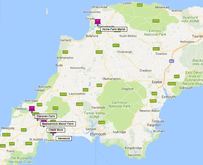the difference we are making
|
In the two images above, you can clearly see the increase in vegetation, especially along the field perimeters. There are more trees in the central area and the salt marsh by the river is wetter. Saltwater MeadowsThe Gaia Trust bought Treraven Farm in 1998 and soon hatched a plan with the Environment Agency and Natural England to re-flood the meadows they had bought. Together, they have realised that vision through a 7-year project to restore 15 hectares of tidal floodplain and as a result, tidal floods are entering Treraven meadows for the first time in over 100 years.
The fields are directly adjacent to the Camel Trail, and were previously used for hay and summer grazing. They have been allowed to flood around the tidal cycle and spring tides now enter the fields through a series of new and existing pipes. The periodic flooding has allowed salt tolerant species to come into the grass sward and increase the overall plant diversity. Carefully planned grazing also helps this process. Birdlife has already benefited from the flooding with lapwing, sandpipers and curlew visiting the fields immediately after the first floods. We hope the latter will breed in future. creating the meadows
Natural England funded a feasibility study in 2003 to develop a design and gain the permissions required to begin the flood meadow creation. By autumn 2006 everything was in place to start construction at Treraven, which 12 weeks to complete.
A number of tidal sluices breach the Camel river flood banks and allow water in during high flood tides, and then release the water gradually as the flood event abates. To see the meadows at their best, check your tide table and make sure there is big tide in the estuary which happens twice a month, normally first thing in the morning and in the evening 7am and 7pm. At the moment viewing these fields will be only possible from the Camel Trail. new mixed woodland
Between 2000 and 2001 and with the help of volunteers and local school children, the Gaia Trust planted nearly 12ha of mixed broadleaved woodland, 3ha of woody shrubs and 3 ha of conifer. At a planting density of 2250 trees per hectare, it means that some 40,500 trees were planted. This new woodland adds to the nearly 13 ha of existing mixed broadleaved woodland.
Nearly twenty years on the new woodland has grown many metres tall and provides valuable habitat for a whole variety of fungi, plants, insects, birds and mammals. It also provides areas for outside education activities including forest school. The broadleaved tree species planted include oak, ash, beech, alder, willow, cherry, birch, small leaved lime, field maple, rowan and sweet chestnut. Woody shrubs include spindle, guelder rose, dog wood and hazel. Conifers include European larch, Douglas fir, Norway spruce, Western hemlock, Scots pine, Western red cedar and Japanese larch. The actual species composition varies between planting blocks. The initial woodland planting was supported by a Forestry Commison Woodland Grant Scheme |





